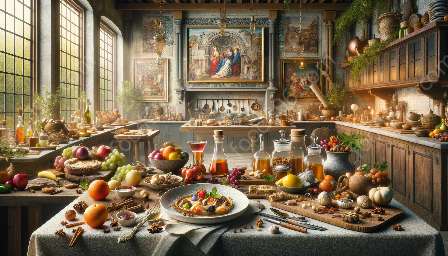The Renaissance era marked a significant shift in the world of cuisine and dining etiquette. As Europe emerged from the Middle Ages, society began to place a greater emphasis on refinement and sophistication in all aspects of life, including food and dining. This period witnessed a transformation in culinary practices, as well as the emergence of new social norms and etiquettes surrounding dining. To fully grasp the evolution of dining etiquette in Renaissance cuisine, it is crucial to understand the historical context in which these changes occurred and their impact on the broader history of cuisine.
Renaissance Cuisine: An Overview
The Renaissance, which spanned roughly from the 14th to the 17th century, was a period of cultural, artistic, and intellectual rebirth in Europe. This era witnessed a renewed interest in the knowledge and achievements of ancient civilizations, leading to a flourishing of the arts, science, and exploration. The Renaissance also brought about significant changes in the culinary landscape, with a renewed focus on the aesthetics, flavors, and presentation of food.
Renaissance cuisine was greatly influenced by the availability of new ingredients, the introduction of exotic spices through trade routes, and the culinary traditions of various regions within Europe. The cuisine of the Renaissance era was characterized by a strong emphasis on balance, harmony, and the refinement of flavors. Dishes were often prepared with meticulous attention to detail, and the use of herbs and spices was central to the flavor profiles of many Renaissance dishes.
The Evolution of Dining Etiquette
As culinary practices evolved during the Renaissance, so too did the social customs and etiquettes surrounding dining. The way meals were served, the use of utensils, and the conduct of diners all underwent significant changes during this period.
Shift in Dining Atmosphere
One notable change in Renaissance dining etiquette was the transformation of the dining atmosphere. Banquets and feasts became increasingly ornate and elaborate, with a strong focus on creating a visually stunning and sensory experience for diners. The presentation of food became a form of art, with great attention paid to the aesthetics of the table setting, the arrangement of dishes, and the use of decorative elements such as floral arrangements and intricate tableware.
Utensils and Table Manners
Renaissance dining etiquette also saw the adoption of new utensils and tableware, as well as the codification of table manners. The use of forks, for example, became more widespread during this period, marking a departure from the previous practice of eating with hands or simple knives. The use of napkins and the arrangement of table settings also became a way to demonstrate refinement and sophistication.
Additionally, specific rules and guidelines governing the behavior of diners at the table began to emerge. This included rules regarding the use of utensils, the order of serving dishes, and proper conduct during meals. These rules were often outlined in etiquette manuals of the time, reflecting the growing importance placed on proper behavior and decorum in dining settings.
Social Significance of Dining
Furthermore, dining during the Renaissance became a symbol of social status and cultural refinement. The ability to host grand banquets and entertain distinguished guests was seen as a mark of wealth and sophistication. As a result, the cultivation of manners and etiquettes related to dining became a way for individuals to showcase their education, social status, and adherence to the standards of the time.
Legacy and Influence
The evolution of dining etiquette in Renaissance cuisine left a lasting legacy that continues to influence contemporary dining practices. Many of the table manners and etiquettes that emerged during this period have been passed down through generations and form the basis of modern dining customs. The emphasis on presentation, refinement, and the social significance of dining that characterized Renaissance cuisine has left an indelible mark on the cultural perception of food and dining.
By understanding the evolution of dining etiquette in Renaissance cuisine, we gain insight into the broader historical and cultural forces that shaped culinary practices and social norms. The Renaissance era stands as a pivotal moment in the history of cuisine, leaving behind a rich tapestry of traditions, flavors, and etiquettes that continue to inform and inspire the culinary world today.

